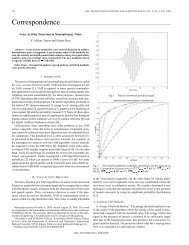Thesis (PDF) - Signal & Image Processing Lab
Thesis (PDF) - Signal & Image Processing Lab
Thesis (PDF) - Signal & Image Processing Lab
You also want an ePaper? Increase the reach of your titles
YUMPU automatically turns print PDFs into web optimized ePapers that Google loves.
68 CHAPTER 5. TREE SEMILATTICES<br />
tree associated to them.<br />
Proposition 4. Let T1 = (t, M1) and T2 = (t, M2). In this case,<br />
and<br />
where M1 �t M2 may not exist.<br />
T1 ∧ T2 = (t, M1 �t M2) , (5.5)<br />
T1 ∨ T2 = (t, M1 �t M2) , (5.6)<br />
Proof. The general infimum definition in equation 5.3 can be easily reduced to a<br />
simpler form if t1 = t2. Then t1 ∧ t2 becomes just t and the projection operator<br />
Pt1∧t2 has no effect because the trees are equal. For that reason the equation may be<br />
rewritten as above.<br />
In the similar way, the general supremum definition at equation 5.4 is reduced to<br />
the above form, because t ∪ t = t.<br />
The above is in fact the situation that occurs when one defines flat erosion and<br />
dilations on the complete inf-semilattice of tree representations. The flat erosion is<br />
the operator ε defined as:<br />
ε(T ) = �<br />
T−b, (5.7)<br />
b∈B<br />
where B is a structuring element, and T−b is the tree representation obtained by<br />
translating the mapping function of T by the vector −b. That is, if T = (t, M), then<br />
T−b = (t, M−b). It is easy to verify that the above operator is an erosion on T L<br />
r .<br />
Indeed, it is distributive with respect to the tree representation infimum.<br />
Using Proposition 4, one obtains that<br />
ε(T ) = (t, �t {M−b|b ∈ B}) . (5.8)<br />
According to the morphological semilattice theory [21], on a complete inf-semilattice,<br />
one can associate to any given erosion an opening γ and any morphological opera-<br />
tor that is derived from compositions of erosions and openings, such as the internal<br />
gradient, dark top-hat transform, and skeletons. Furthermore, the adjoint dilation δ
















